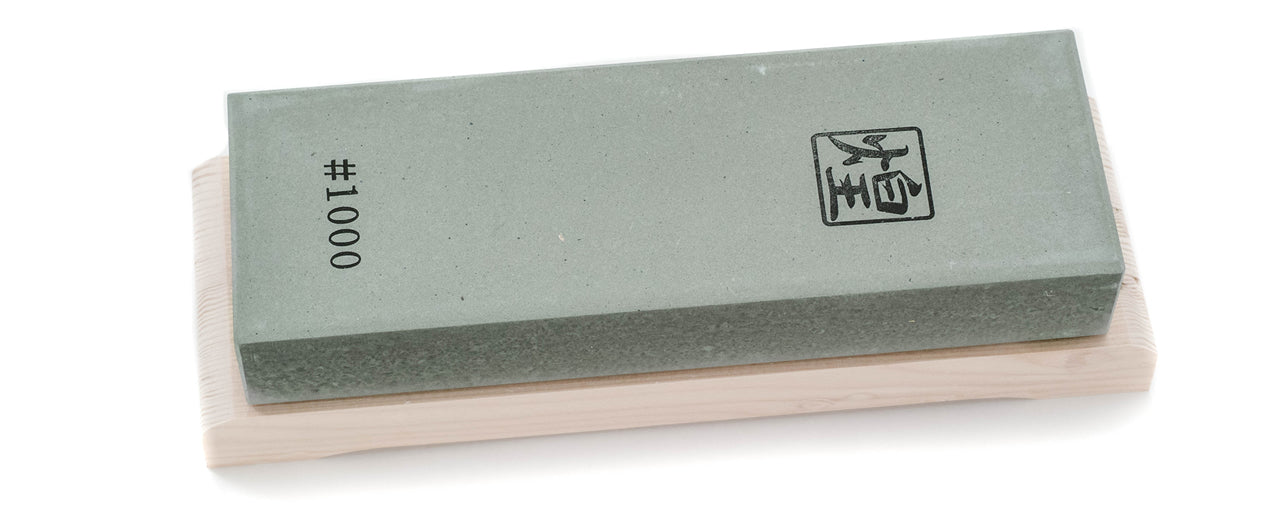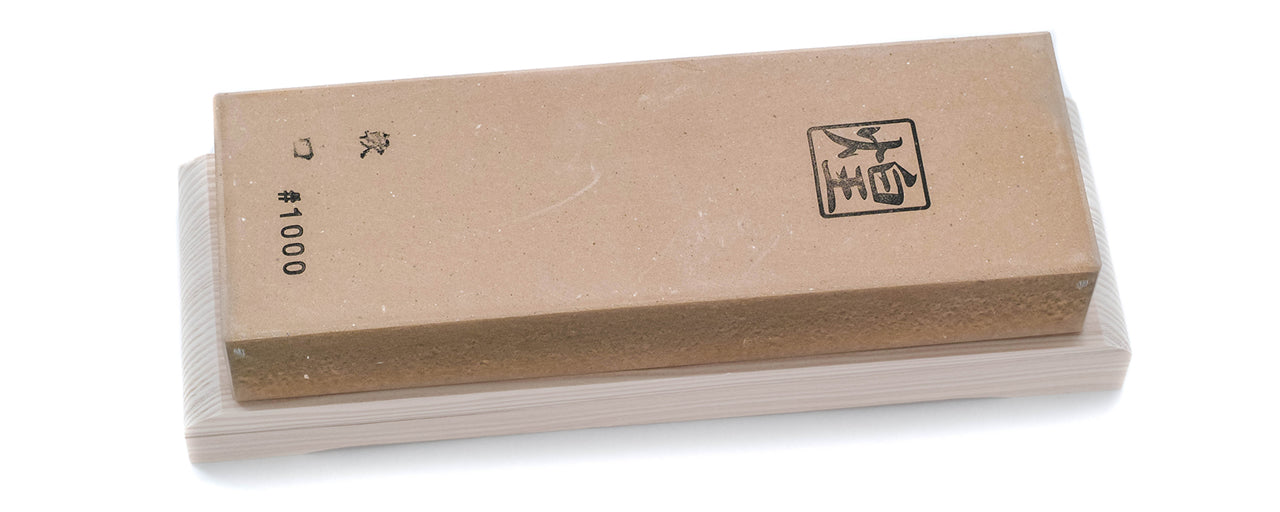How to choose a whetstone / knife sharpening stone
Whetstones are very important tools for sharpening kitchen knives.
They come in a wide range of materials, manufacturing methods, and degrees of roughness. It is important to select the appropriate one in order to sharpen the target kitchen knife effectively.
The following is an introduction to how to select the right whetstone based on those used by the sharpening craftsmen of Sakai Ichimonji Mitsuhide for their own sharpening work.
1) Why are there so many kinds of Whetstones?
When we think about why there are so many types of whetstones, we believe it is because Japanese people are very particular about the sharpness of their kitchen knives.
Japanese cooking and cuisine requires sharpness in kitchen knives because it is a cuisine that draws out the maximum flavor from the ingredients themselves.
This is why there are unique single-edged Japanese kitchen knives, and why sharpening techniques and whetstones have been developed to bring out the sharpness of these knives.
Therefore, it is important to first understand the difference between each type of whetstone.
2) Types of Whetstones: Natural VS Synthetic
There are two main types of whetstones: natural whetstones and synthetic whetstones.
Originally, whetstones were mainly stones harvested from natural mines.
But these whetstones, which are a natural resource, are mined in limited quantities, and the amount mined has been slowly decreasing year over year.
In contrast, synthetic whetstones are said to have originated in the United States around the 19th century when abrasive materials were formed, and today synthetic whetstones are used not only for knives but also for almost all other types of sharpening.
Synthetic whetstones have many types of abrasive grains which are classified by size of the grain (from rough grain size to fine.) There are also many kinds of main raw materials used and the manufacturing methods used to produce these whetstones are advancing rapidly.
There are two main reasons why the usage frequency of synthetic grinding stones has increased so much. One is the stable quality of these whetstones and the other is the well-defined standards that are more characteristic of industrial use.
These standards allow the user to choose the "number" (roughness), material, and manufacturing method of the whetstone according to the intended use.
On the other hand, the quality of natural whetstones varies from one piece to another, and the quantity of natural whetstones in circulation is decreasing year by year, making them rare, expensive, and sometimes difficult to predict when it comes to sharpening results.
However, natural whetstones are used by many knife enthusiasts who pursue sharpening because knives sharpened on natural whetstones can produce increditbly smooth cuts.
3) Whetstone Grit: How to Choose for Sharpening Knives
The most important point in selecting a whetstone is the number of the grit size.
The lower the number, the rougher the whetstones are. Conversely, the higher the number, the finer the whetstones are.
A rough stone with a low number has a very rough surface and high abrasiveness. It can restore the cutting ability of a knife very fast , but it can easily scratch the blade.
On the otherhand, a whetstone with a high grit number has a smooth surface but low abrasive ability. It can fix scratches on knives until a blade truly shines.
Typically, we can divide the whetstones into 3 types by their grit size; Rough Stones, Medium Stones and Fine Stones.
1) Rough Stone
This is the roughest of the 3 types of whetstones.
The number is around 80 - 400 grit. 200 grit is standard.
The lower grit has higher abrasive ability which is suitable for fixing chips or reshaping a blade.
2) Medium Stone
The standard number of a medium stone is around 1000 grit.
This is the standard whetstone for sharpening, and is the first kind of whetstone you should buy.
Basically, they are used to fix dull knives and restore cutting ability to a knife's blade.
Also, they are used for removing the scratches created by a rough stone.
3) Fine Stone
The number is 2000 - 10000 grit and can go even further beyond.
This type of stone is used for the final process of sharpening. You may seem them sometimes referred to as "finishing stones."
It is so fine that can sharpening using this whetstone can even remove the scratches from a medium stone.
It is often used for Japanese knives (such as Yanagiba knives), which require extremely delicate sharpness.
| Rough Stone | Medium Stone | Fine Stone |
| #80 - #400 | Around #1000 | Over #2000 |
| Used for fixing chips and reshaping | Used for restoring cutting ability | Used for special and final sharpening techniques for Japanese knives, like "small edge pulling" and "back pressing." |
Because each type of whestone has its own role to play, it is ideal to have all 3 types where possible.
However, it may be difficult for a person who is not used to sharpening to work with all 3 types at the same time.
Therefore, we recommend a medium stone for your first whetstone as it's the most general purpose and is designed to restore cutting ability.
Then, the next one you should buy is a rough stone in case any of your knives become chipped or require some reshaping work.
If you continue sharpening with a medium whetstone alone, the steel at the blade's cutting edge will decrease and become thicker and thicker. One factor of a sharp knife is just how thinly sharpened the blade is. To make a blade thin, it needs sharpening from a rough stone beacause a medium stone does not have enough abrasive ability to reshape the blade.
After having the first two types, you can then look into getting a fine stone. Japanese knives also require sharpening methods such as "small edge pulling" and "back pressing", so it's ideal to get the fine and rough whetstones at the same time if possible.
In conclusion, the buying order is "Medium Stone" → "Rough Stone" → "Fine Stone"
4) How to Choose a Whetstone: Manufacturing Method
There are a wide variety of types of the abrasive grains (abrasive material), which are the main raw material of whetstones, through to the bonding agent that binds the grains together, and even the manufacturing method used to form and harden the grains.
Types of Abrasive Grains (Abrasive Materials) for whetstones
Abrasive grains are the main raw materials for whetstones, and there are various types of grains necessary for sharpening blades, which vary in hardness and viscosity.
Abrasive grains are broadly classified into two categories: general abrasive grains and super abrasive grains.
-
General abrasive grains
Most of the whetstones we see are made of general abrasive grains, which are widely used because they are reasonably priced. There are various types of abrasive grains, mainly "alumina (A)" and "silicon carbide (C)," and the properties of abrasive stones vary depending on the hardness of the particles, which can be angular or rounded. -
Super abrasive grains
Super abrasive grains are made from diamonds and CBN (boron), and while they are extremely hard and wear-resistant, they are also more expensive in comparison. Originally, they were used to sharpen super steel, ceramics, diamonds, and other hard materials, but nowadays they are increasingly manufactured for kitchen knives as well.
Bonding agent and manufacturing process for whetstones
The bonding agent is used for holding the abrasive grains of a whetstone together.
There are now a variety of bonding agents and manufacturing methods. They affect the properties of the whetstone, so they are one of the most important factors that users should consider when choosing a whetstone.
The three most common types of bonding agents are Vitrified, Resinoid, and Magnesia.
| Manufacturing Method | Features | Usage |
| Vitrified Ceramic or vitreous materials such as soluble clay and feldspar are baked at temperatures exceeding 1000°C | - The most abrasive of all whetstones, and its greatest feature is that high abrasive ability. - It has many pores, and surface clogging is rare. | Suitable for rough stones. |
| Resinoid Synthetic resins such as phenol and epoxy are hardened by baking at a relatively low temperature of around 200°C | - The stone has low water absorbency, so there is no need to soak it in water before sharpening. - The elasticity of the whetstone makes it easy to hit the blade when sharpening and produces a fine, fine finish. | Suitable for medium to fine stones. |
| Magnesia Magnesia cement binder kneaded at room temperature and dried rather than baked | - It has high abrasive ability and can sharpen to a fine finish like a natural whetstone. - Like Resinoid, it has low water absorbency, so there is no need to soak it in water before sharpening. | Suitable for all stones from rough to fine. |
Which method should we choose for the first whetstone?
Whetstones are surprisingly susceptible to changes in temperature and humidity, and it is common to hear of whetstones cracking or breaking when used without knowing this. So always be careful when using your whetstone.
Vitrified whetstones are relatively easy to handle because they do not change over time and are less likely to crack.
5) How to Choose Whetstone Size
There is a general standard of size concerning synthetic whetstones, however each manufacturer may have its own size standard and can be slightly different.
There are 3 typical sizes: Size S, M, L
| SIZE S | SIZE M | SIZE L |
| 205×50×25(mm) | 205×50×50(mm) | 205×75×50(mm) |
| Good for beginners to sharpening due to their size and ease of use. | Good for frequent sharpeners, as whetstones decrease quickly with constant usage. | Good for those sharpening large or wide knives, like buckwheat noodle knives. |
6) Our Whetstone Recommendations
These are some of our recommendations that our sharpeners and craftsmen usually use.
Of course, we use other whetstones too depending on feeling and the nature of the steel, but we hope this will be helpful for you. If you have questions, you can always contact us and ask!
Sharpening can be fun, as well as relaxing. We encourage you to give it a try to help keep your knives in perfect condition, so you can use them safely and continue to make fantastic cuisine.
| Knife | Rough | Medium | Fine |
| Single Edge Carbon Steel | GC #220 | ||
| Single Edge Stainless Steel | GC #220 | ||
| Double Edge Carbon Steel | PA #220 | ||
| Double Edge Stainless Steel | GC #220 | ||
| For Home Use | PA #220 |


































